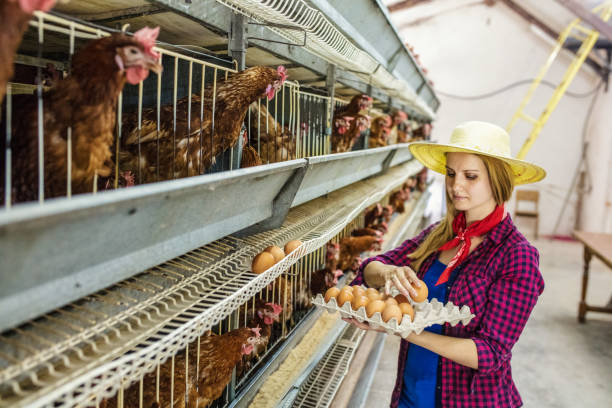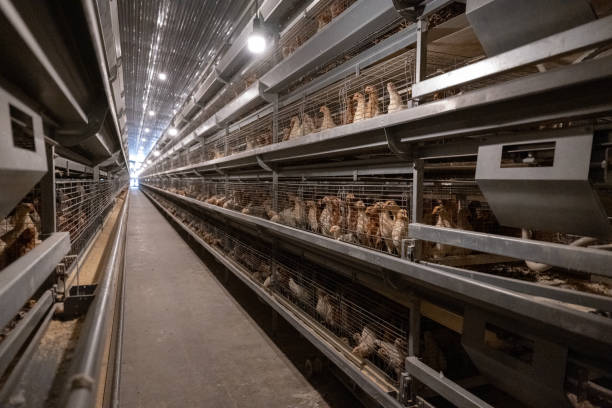
Optimizing Poultry Farming: Cage Equipment Solutions for 10,000 Birds
Optimizing Poultry Farming: Cage Equipment Solutions for 10,000 Birds
Poultry farming, particularly egg and broiler production, is a cornerstone of food security and economic growth in many African nations. However, achieving optimal productivity and profitability requires more than just ambition. Smart management and the right equipment are paramount. Scaling up to a flock of 10,000 birds demands a strategic approach, and the selection of appropriate cage equipment is critical. This article delves into the key considerations for optimizing poultry farming operations with cage systems, specifically tailored for a 10,000-bird operation.
Understanding the Landscape of Poultry Cage Systems
Before diving into specific solutions, it’s crucial to grasp the types of cage systems available. These can broadly be categorized into:
Layer Cages: Designed specifically for egg-laying hens, these cages prioritize egg collection efficiency and hen comfort, directly impacting egg production. Layer cages come in various configurations, including A-type and H-type, each offering distinct advantages in terms of space utilization and automation.
Broiler Cages: Tailored for meat-producing birds, broiler cages emphasize rapid growth and efficient feed conversion. They are typically larger than layer cages to accommodate the larger size of broilers and are designed to minimize leg problems and maximize weight gain.
Battery Cages: This is a term often used to describe multi-tiered layer or broiler cages, particularly those with automated feeding, drinking, and manure removal systems. While offering high-density housing, it’s important to ensure these systems meet animal welfare standards.
The choice between these systems depends entirely on whether you are raising laying hens for egg production or broilers for meat production. It’s a foundational decision that precedes all other equipment choices.
Key Considerations When Choosing Cage Equipment for 10,000 Birds
Scaling to a poultry farm with 10,000 birds is a significant undertaking. Careful planning and selection of the right equipment are crucial for success. Several factors will influence the final decision:
Space Availability: The footprint of your poultry house is a primary constraint. If land is limited, high-density systems like H-type layer cages or multi-tiered broiler cages may be the most efficient way to maximize bird capacity. A-type cages are also an option for space-saving, depending on the overall configuration.
Climate: African climates can be harsh, with extreme heat and humidity. The cage system must be designed to facilitate proper ventilation and temperature control. Features like well-ventilated cage designs, fans, and even evaporative cooling systems may be essential to maintain bird comfort and productivity. Consider building orientation when designing your farm, as well as roof insulation materials that will help reflect heat away from the building.
Labor Costs and Availability: Manual labor can be costly and inconsistent. Investing in automated systems for feeding, watering, manure removal, and egg collection can significantly reduce labor requirements and improve efficiency. This is particularly important in larger operations like a 10,000-bird farm. Weigh the initial investment in automation against the long-term savings in labor costs.
Biosecurity: Disease outbreaks can decimate a poultry flock. Cage systems should be designed to facilitate cleaning and disinfection. Features like sloped floors for easy washdown and closed housing environments can help minimize the risk of disease transmission. Implement strict biosecurity protocols, including foot baths, hand washing stations, and restricted access to the poultry house.
Investment Capital: Poultry farming equipment requires significant capital investment. Understanding one’s available funds, the return on investment possible, and the long-term financing options are important. Cage quality determines the usage age, so comparing the quality and price performance of the equipment is important.
Egg Collection Systems: The system you choose to collect eggs should involve as little human labor as possible. You should have a convenient collection to avoid the number of broken eggs and labor costs involved.
Waste Removal Systems: It is important to efficiently plan how chicken waste is handled. If waste is not removed in a timely manner, it will affect indoor air quality and is more prone to disease.
Specific Cage Equipment Options for Layer Operations (10,000 Birds)
For a 10,000-layer operation, the following cage equipment considerations are paramount:
Cage Type: A-type cages are cost-effective and suitable for smaller to medium-sized farms. H-type cages offer higher density and automation capabilities, ideal for larger-scale operations where space is a premium. Consider the pros and cons of each based on your space and budget.
Tier Configuration: The number of tiers in the cage system affects space utilization. While more tiers increase bird density, it’s crucial to ensure adequate ventilation and accessibility for each tier. A balance must be struck to optimize space without compromising bird welfare.
Automated Feeding System: Automated feeding systems ensure consistent feed delivery, reducing waste and labor. Choose a system that is reliable, easy to maintain, and provides uniform feed distribution to all birds.
Nipple Drinking System: Nipple drinkers provide a clean and efficient water source, minimizing spillage and promoting better hygiene. Ensure the system provides adequate water flow for all birds and is easy to clean and maintain.
Egg Collection System: Automated egg collection systems minimize egg breakage and labor costs. Conveyor belts gently transport eggs to a central collection point, improving efficiency and egg quality.
Manure Removal System: Automated manure removal systems are essential for maintaining hygiene and reducing ammonia levels in the poultry house. Scraper systems or belt systems efficiently remove manure, improving air quality and bird health. Choosing a good waste removal system is key to maintaining a healthy environment for your birds.
Specific Cage Equipment Options for Broiler Operations (10,000 Birds)
For a 10,000-broiler operation, the priorities shift to maximizing growth and minimizing mortality. Here are the key cage equipment considerations:
Cage Size and Density: Broiler cages must be large enough to accommodate the growing size of the birds. Overcrowding can lead to stress, reduced growth rates, and increased mortality. Determine the optimal bird density per cage based on breed and expected growth rates.
Flooring: The cage flooring must provide adequate traction to prevent leg problems and breast blisters. Plastic or wire mesh flooring is commonly used, but it’s important to ensure the mesh size is appropriate to prevent foot injuries.
Feeding and Watering Systems: Similar to layer operations, automated feeding and watering systems are crucial for broiler farms. Ensure the systems can deliver adequate feed and water to support rapid growth.
Ventilation: Broilers are highly susceptible to heat stress. Adequate ventilation is essential, and you should invest in an appropriate ventilation system that provides sufficient airflow to remove heat and humidity. This may include fans, side vents, and even cooling pads.
Manure Removal: Broilers produce a large amount of manure, so an efficient manure removal system is critical. Belt systems are often used in broiler operations. Daily removal of manure can improve air quality and reduce the risk of disease.

The Importance of Animal Welfare
While optimizing productivity is crucial, animal welfare must be a central consideration. Ensure that your cage system provides adequate space, ventilation, and access to feed and water. Avoid overcrowding and implement management practices that promote bird health and well-being. Ethical poultry farming not only aligns with consumer demands but also contributes to better productivity and profitability in the long run.
Working with a Supplier and Installation Considerations
Selecting the right cage equipment supplier is a critical step. Look for a company with a proven track record, reliable products, and excellent after-sales support. Inquire about the installation process and ensure the supplier provides adequate training on system operation and maintenance. Proper installation is key for system longevity and optimal performance.
Before installation, prepare the poultry house to meet the supplier’s specifications. Ensure the floor is level, the electrical wiring is adequate, and the ventilation system is in place. A well-prepared environment will facilitate a smooth installation process.
Maintenance and Long-Term Use
Regular maintenance is essential for maximizing the lifespan of your cage equipment. Implement a preventative maintenance schedule that includes cleaning, lubrication, and inspection of all components. Address any repairs promptly to prevent further damage and ensure optimal performance.

Keep accurate records of maintenance activities, feed consumption, egg production (for layers), and bird weights (for broilers). This data will help you identify potential problems early and make informed management decisions. By following a proactive maintenance program, you can extend the lifespan of your cage equipment and ensure a profitable poultry farming operation.
Leveraging Automation for Increased Efficiency
Automation is key to maximizing efficiency in a 10,000-bird operation. Automation in feeding, watering, egg collection, and manure removal can significantly reduce labor costs and improve overall productivity. Sensors and monitoring systems can provide real-time data on temperature, humidity, and ammonia levels, allowing you to make adjustments to optimize the environment for your birds.
Seeking Expert Advice
Poultry farming is a complex undertaking, and seeking expert advice is always beneficial. Consult with poultry veterinarians, nutritionists, and experienced farmers to gain insights into best practices for managing your flock. Stay updated with the latest research and advancements in poultry farming to continuously improve your operation.
Optimizing poultry farming with cage equipment for 10,000 birds requires careful planning, strategic equipment selection, and a commitment to animal welfare. By considering factors such as space availability, climate, labor costs, biosecurity, and animal welfare, you can choose the cage system that best suits your needs and budget. Investing in automation, implementing a preventative maintenance program, and seeking expert advice are essential for maximizing the profitability and sustainability of your poultry farming operation. The right cages will help you create a business model that sets you up for success.

